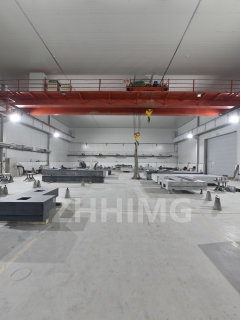Optical waveguide positioning devices are essential components in modern telecommunications networks and other high-tech fields. They enable the precise alignment of optical components and facilitate the efficient transmission of optical signals. One of the materials frequently used for manufacturing waveguide positioning devices is granite. In this essay, we will explore the advantages and disadvantages of using granite components for optical waveguide positioning devices.
Advantages of Using Granite Components
1. High Stability and Durability
Granite is a very hard and dense material that is known for its high stability and durability. The stiffness of this material makes it suitable for applications that require precise alignment and high accuracy. The rigidity of granite components minimizes the deformation caused by temperature fluctuations, ensuring reliability and a long service life.
2. High Thermal Stability
Granite has a low coefficient of thermal expansion, meaning that its shape will not change significantly with temperature changes. This characteristic makes it an excellent material for applications where temperature stability is crucial, like waveguide positioning devices. High thermal stability helps the device to maintain its accuracy even when subjected to extreme temperatures.
3. Excellent Damping Properties
Granite has excellent damping properties, which means that it minimizes vibration and noise. This characteristic is beneficial for waveguide positioning devices, as it ensures accurate and stable positioning of the optical components. The device will be less prone to interference from environmental vibrations or other mechanical disturbances.
4. High Chemical Resistance
Granite is a chemically inert material, meaning that it is resistant to chemical corrosion and can withstand exposure to various chemicals. This resistance is beneficial for waveguide positioning devices since it helps to protect the optical components. Granite components are less prone to degradation, ensuring long-term reliability.
Disadvantages of Using Granite Components
1. High Cost
Compared to other materials, granite is quite expensive, and its processing is also costly. The overall cost of producing a waveguide positioning device made of granite may be higher than devices made of other materials.
2. Heavy Weight
Granite is a dense material that can weigh up to three times more than an equivalent volume of aluminum. This characteristic may make the positioning device heavier than other devices made of alternative materials. The weight may impact the ease of handling and transportation.
3. Limited Design Flexibility
Granite is a difficult material to work with, and it is not easy to machine into different shapes and sizes, especially for complex designs. The rigidity of granite limits the design freedom, and it may be challenging to implement specific features or shapes using it.
Conclusion
In conclusion, granite is an excellent material for making waveguide positioning devices, especially for applications that require high accuracy, stability, and durability. Granite components are stable, durable, and resistant to environmental factors, making them suitable for high-performance optical systems. The disadvantages of using granite are the high cost, weight, and limited design flexibility. However, the benefits of using granite components outweigh the disadvantages, making it a preferred material for the production of high-performance waveguide positioning devices.
Post time: Nov-30-2023

